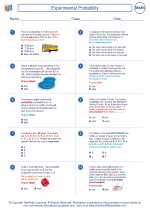Progressions
A progression is a sequence of numbers in which each term after the first is obtained from the preceding term by adding or subtracting a constant. There are several types of progressions, including arithmetic progressions, geometric progressions, and others.
Arithmetic Progression (AP)
An arithmetic progression is a sequence of numbers in which the difference between any two consecutive terms is constant. This difference is called the common difference, denoted by d. The general form of an arithmetic progression is:
a, a + d, a + 2d, a + 3d, ...
Where a is the first term and d is the common difference.
Geometric Progression (GP)
A geometric progression is a sequence of numbers in which each term after the first is obtained by multiplying the preceding term by a constant. This constant is called the common ratio, denoted by r. The general form of a geometric progression is:
a, a r, a r2, a r3, ...
Where a is the first term and r is the common ratio.
Sum of Terms in a Progression
The sum of the first n terms of an arithmetic progression can be calculated using the formula:
Sn = n/2 [2a + (n - 1)d]
Where Sn is the sum of the first n terms, a is the first term, d is the common difference, and n is the number of terms.
The sum of the first n terms of a geometric progression can be calculated using the formula:
Sn = a(1 - rn)/(1 - r)
Where Sn is the sum of the first n terms, a is the first term, r is the common ratio, and n is the number of terms.
Study Guide
- Understand the concept of progressions and the difference between arithmetic and geometric progressions.
- Learn how to find the common difference in an arithmetic progression and the common ratio in a geometric progression.
- Practice calculating the sum of the first n terms in both arithmetic and geometric progressions.
- Work on problems that involve finding specific terms or the sum of terms in a given progression.
- Explore real-world applications of progressions, such as calculating financial investments or population growth.
By mastering the concepts and formulas related to progressions, you'll be well-prepared to tackle problems involving arithmetic and geometric sequences and series.
[Progressions] Related Worksheets and Study Guides:
.◂Math Worksheets and Study Guides Eighth Grade. Experimental Probability

 Worksheet/Answer key
Worksheet/Answer key
 Worksheet/Answer key
Worksheet/Answer key
 Worksheet/Answer key
Worksheet/Answer key
